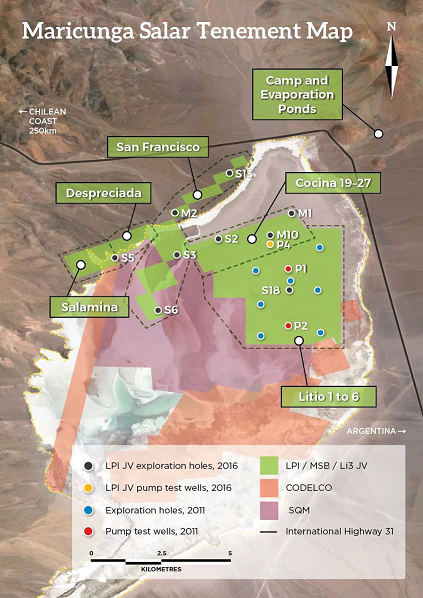
Vancouver, British Columbia - Bearing Resources Ltd. ("Bearing" or the "Company") (TSX Venture: BRZ) has received drill results from Li3 Energy Inc. (“Li3”) from the ongoing exploration program at the Maricunga lithium brine project located in Chile (the “Maricunga Project”). Bearing has signed a binding LOI with Li3 Energy Inc. (“Li3”) to acquire its interest in the Maricunga lithium brine project as announced on December 11, 2016. Li3 holds a 17.7% interest in the project along with Minera Salar Blanco (“MSB”) and Lithium Power International Limited (“Lithium Power”) at 32.3% and 50% respectively. Under the terms of the joint venture, Lithium Power has agreed to fund exploration and development costs with both Li3 and MSB having a free carry until the completion of a definitive feasibility study.
Lithium Power is completing a drill program which is anticipated to be done in January 2017, focused on drill testing of tenements outside of the existing resource area, and will lead to a revised resource estimate due in H1/2017.
Exploration Results
Assay results for four holes are provided all of which were drilled on “old code” tenements. Results were initially released by Lithium Power on November 11, December 7 and December 21, 2016 and are summarized below in table 1.Highlights include results from Hole M1 that reported 1,447 mg/L lithium over 75m and hole S5 that returned 1005 mg/l lithium over 186 m.All holes bottomed in lithium bearing brine. Drill holes were vertical and represent true thicknesses.
Table 1 Summary of Results

Assay results released are from exploration drilling on the Cocina, San Francisco and Salamina tenements (c.f. Figure 1).
Figure 1: Maricunga Salar Tenement Map showing location of drill holes

Jeremy Poirier, President and Chief Executive Officer of the Company commented: “We are very pleased with the exploration results released by the joint-venture to date. The results continue to demonstrate the robust nature of the Maricunga project as being one of the highest-grade undeveloped lithium brine projects, in addition to the significant potential for resource growth, most notably on ‘old-code’ tenements.”
QA/QC:
Drilling was by rotary drilling that provide cuttings for lithological logging and for geological interpretation. Brine samples were collected at 6 m intervals during drilling. This involved purging brine from the drill hole and then taking a sample corresponding to the interval between the rods and the bottom of the hole. The brine sample was collected in a clean plastic bottle and filled to the top to minimize air space within the bottle. Brine samples collected following the purging of the holes are homogenized as brine is extracted from the hole using a bailer device. Each bottle was taped and marked with the sample number and details of the hole and the time of the sample were noted. The University of Antofagasta in northern Chile was used as the primary laboratory to conduct the assaying of the brine samples collected as part of the drilling program. They also analyzed blanks, duplicates and standards, with blind control samples in the analysis chain. Additional details of the QA/QC program and sampling procedures are provided in the Lithium Power press releases mentioned.
Robert Cameron, P.Geo., who is a technical consultant to the Company and is a qualified person within the context of National Instrument 43-101, has read and takes responsibility for this news release.
ON BEHALF OF THE BOARD
Signed "Jeremy Poirier"
Jeremy Poirier, Director President and CEO
FOR FURTHER INFORMATION PLEASE CONTACT:
Jeremy Poirier | Director President & CEO
Phone: + 1 604 262 8835
Email: [email protected]
![]()
Neither the TSX Venture Exchange nor its Regulation Services Provider (as that term is defined in the policies of the TSX Venture Exchange) accepts responsibility for the adequacy or accuracy of this release.
About Bearing Resources Ltd.
Bearing is an exploration and development company. On December 9, 2016, it entered into a Binding LOI agreement (the “Binding LOI”) with Li3 Energy Inc. to acquire the advanced advanced-stage Maricunga project located in Chile (the “Maricunga Project”), which represents one of the highest-grade development opportunities in the Americas. Assuming completion of the transactions contemplated by the Binding LOI, Bearing will have an undivided 17.7% interest in the project with all expenditures through to the delivery of a Definitive Feasibility Study (DFS) fully-funded by its joint-venture partners. The Maricunga Project has had in excess of US$25 million of exploration to date. Bearing currently holds a portfolio of prospective, grass-roots exploration projects in gold district of the Yukon near Golden Predator.